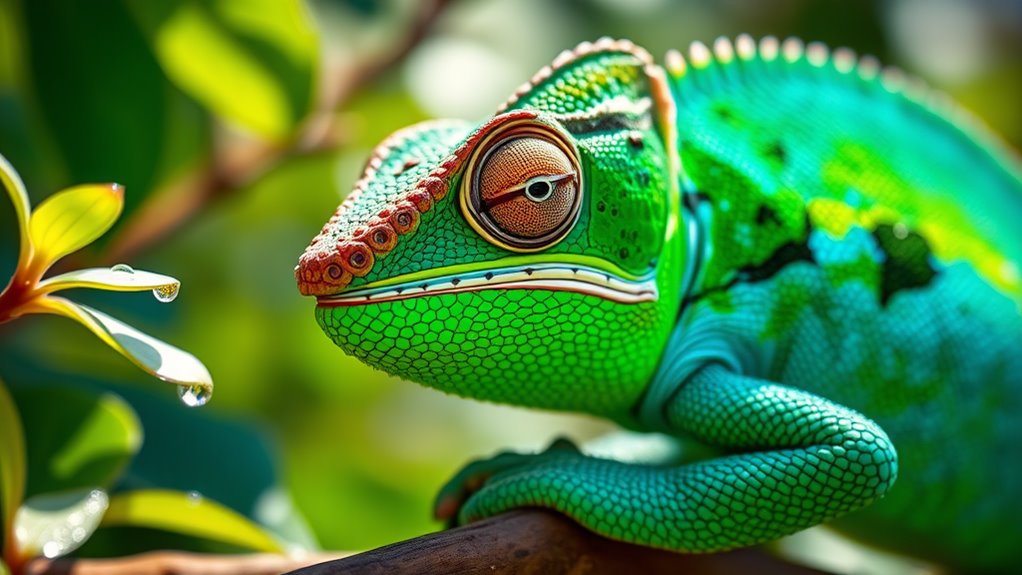
Chameleons change colors due to specialized cells called chromatophores that expand and contract, altering their pigmentation. Hormonal shifts and environmental stimuli, like light and temperature, also play essential roles in this process. These color changes serve various purposes, including temperature regulation and social communication, signaling emotions or territorial claims. Additionally, genetic and dietary factors contribute to their unique color displays. Discovering the intricate connections between these elements reveals even more fascinating insights into chameleons' adaptive behaviors.
While you might think chameleons change color mainly for camouflage, the truth is that their remarkable ability stems from a complex interplay of biological, environmental, and social factors. When you explore the biological mechanisms, it becomes clear that chameleons rely on specialized pigment-containing cells in their skin. These cells, known as chromatophores, expand or contract to alter color. Melanin granules present within these cells play a vital role, as their dispersion or concentration affects light reflection, particularly blue light from scattering cells.
Additionally, iridophores, another type of specialized cell, contain nanocrystals that reflect various wavelengths of light, further contributing to the chameleon's dynamic color palette. Color changes may reflect hormonal shifts that occur in response to environmental stimuli, showing the intricate connection between biology and behavior.
Hormonal regulation also influences these color changes. Hormones control the activity of melanin-containing cells, which means that emotional states, environmental stimuli, and physiological needs can all prompt shifts in color. The autonomic nervous system is involved, sending neural signals that facilitate these changes.
You may notice that chameleons respond to varying light conditions, not solely for camouflage but also for temperature regulation. When temperatures rise, chameleons may adopt lighter colors to reflect heat, while darker colors can help absorb warmth during cooler periods.
Environmental changes don't solely dictate color for blending in; they also mark responses to stress or discomfort. For instance, handling by humans can induce color changes due to stress. Humidity and moisture levels, albeit less documented, might also influence coloration through similar mechanisms.
Beyond the physical and environmental, emotional factors greatly impact color display. Chameleons express their emotional states through color, signaling stress or excitement to others. During social interactions, especially in competitive or mating scenarios, you'll find that color changes serve as visual cues to convey mood or readiness.
These intricate displays can also help with gender identification, as some species exhibit distinct color differences between males and females, aiding in social recognition. Beyond social interactions, chameleons use color for territorial marking, establishing boundaries to deter rivals.
As you observe their behavior, these patterns become apparent in their mating displays, where specific colors and patterns play a role in attracting partners.
It's fascinating to note that species-specific variations contribute to these color changes. Genetic differences among species lead to unique color palettes, influenced by evolutionary adaptations for camouflage in their specific habitats.
Additionally, dietary factors can also affect coloration, showcasing the interconnectedness of their biology and environment. As chameleons mature, age-related changes in color can reflect their developmental stages, emphasizing how these factors intertwine throughout their lives.
Ultimately, the causes of color change in chameleons are multifaceted, weaving together biology, environment, and social dynamics into an enthralling tapestry of adaptation and communication.
Conclusion
In summary, chameleons change colors primarily due to environmental factors, social interactions, and physiological responses. Their unique ability to blend in or display vibrant hues is akin to a mood ring, reflecting their emotional state and surroundings. This color change plays an essential role in communication, camouflage, and temperature regulation. By understanding these complex mechanisms, you can appreciate the fascinating adaptability of these reptiles, reminding us that nature is as intricate as a well-crafted smartphone app.



